- Part I. Research Outline / Introduction / 1. Actual conditions of pregnancy and delivery / 2. Attitude and awareness toward parenting
- Part II. 3. Child-rearing and the relationship of husband and wife / 4. Child-rearing environment
- Part III. 5. Balancing work and family during pregnancy and child-rearing / 6. QOL during pregnancy/child-caring period (This article)
Chapter 5. Balancing work and family during pregnancy and child-rearing
Among wives during pregnancy who responded to the survey, the percentage of wives who are working is 30.4%. However, 47.4% of wives have quit working before birth.
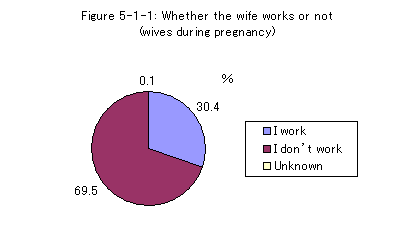
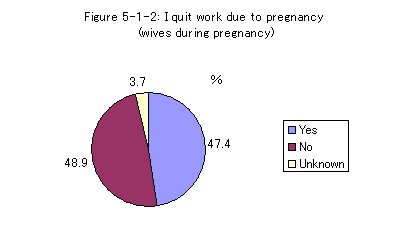
The biggest reason they decided to quit working is "problems related to pregnancy and delivery," 45.5%, followed by "wanted to concentrate on parenting," 37.1%, "problems related to job," 32.5% and "problems related to myself," 19.1%.
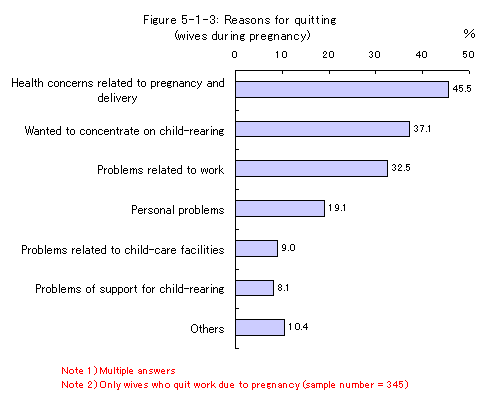
Figure 5-1-4 shows wives' feelings about quitting work. 61.7% of wives, the majority of them answered that "Since I quit working on my own will, I am satisfied now,"28.7% replied that "Although I wanted to continue if possible, I am satisfied now." 3.5% said "I regret it now because I wanted to continue if possible." We cannot overlook the fact that nearly 30% of wives were hoping to keep working.
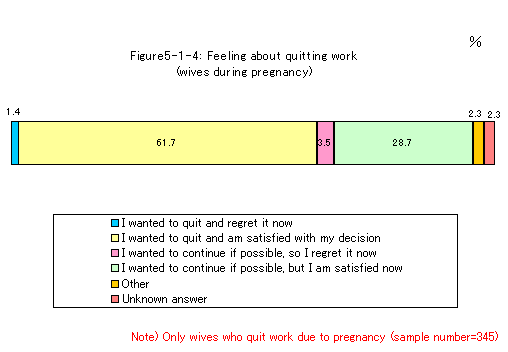
Although 89.6% answered "yes" to the question "Do the office, your superior, and colleagues take your physical condition into consideration?" The percentage "shortened work time or chose flex work during pregnancy" is 37.6%, which is not at all high. Among the freeform answers submitted, quite a few complained that "Though I had awful morning sickness, my pregnancy was not very visible during early pregnancy so I couldn't gain understanding from my workplace." Many also mentioned the difficulty of commuting and the rush hour. These might be the reasons for taking the opportunity to quit work during pregnancy.
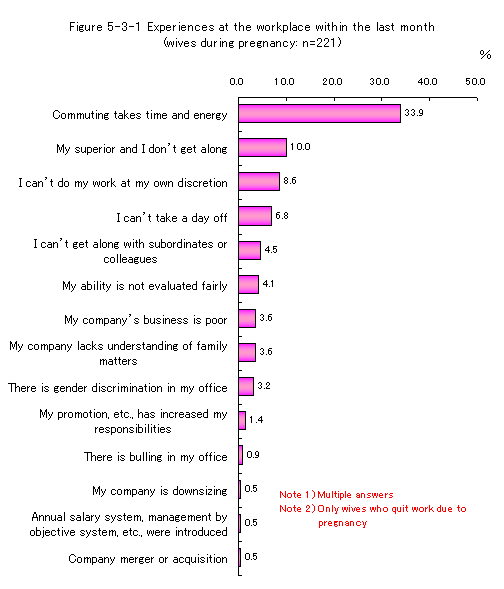
The percentage of wives who work during child-rearing (mothers with 0-year-old, 1-year-old, 2-year-old children) is much lower, 22.8%.
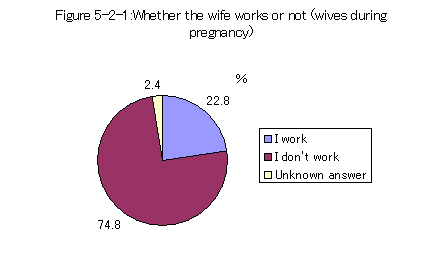
The percentage is 13.2% when the child is 0-year-old, 27.9% when 1-year-old, 34.6% when 2-year-old. As for working status, wives with a "full-time job" were 49.2%, and those with "part-time job" were 28.6%. The number of people working during pregnancy decreased from 60.7% for those with full-time jobs, while increased from 9.6% for those with part-time jobs.
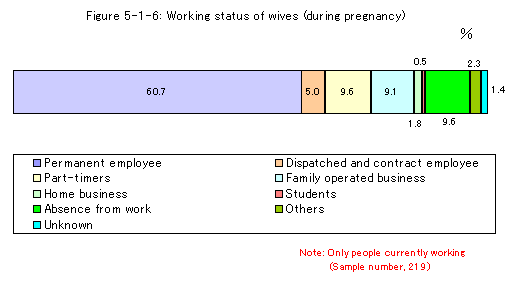
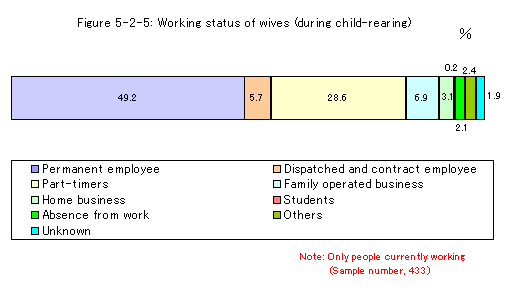
Most wives who continued work after pregnancy or childbirth are employed by companies or offices that offer child-care leave, accounting for the 72.8% of those continuing work.
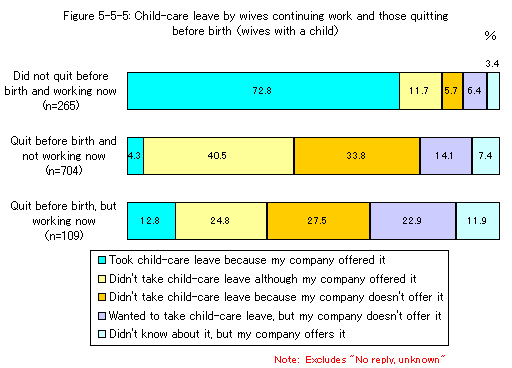
With respect to the husbands of pregnant wives, although 34.6% of them hoped to take the child-care leave, that did not correlate to whether his wife had a job or did not. Figure 5-5-4 shows the availability and actual taking of child-care leave by wives and husbands during child-rearing.
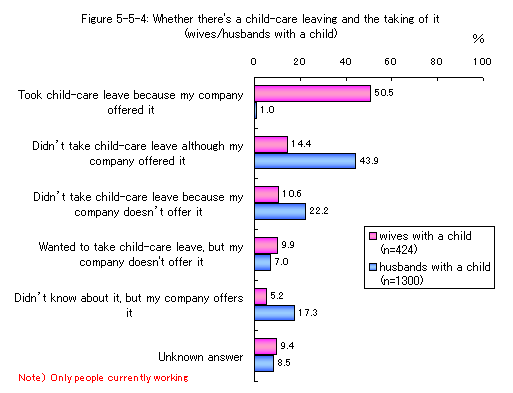
Figure 5-3-2 shows the stress experienced by wives or husbands at the workplace in the last one month. The stress that both felt most was "not being able to spend a lot of time with the child because I am busy at work". The second cause of stress for wives was "balancing working and child-raising is so hard that my health sometimes suffers," accounting for 22.6%, which indicates a serious problem. The top three sources of stress for husbands are related to problems of not being able to adequately fulfill their role as the father in the family. Perhaps this stress is also reflected in the higher dissatisfaction expressed by husbands in balancing work and family life than wives both during pregnancy and the child-care period.
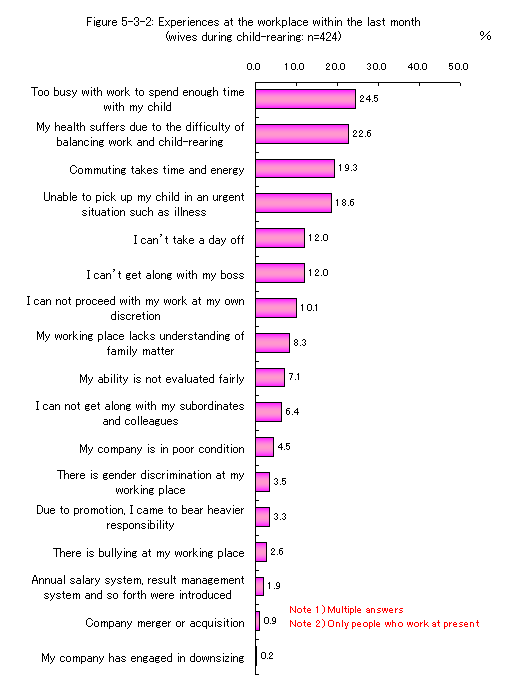
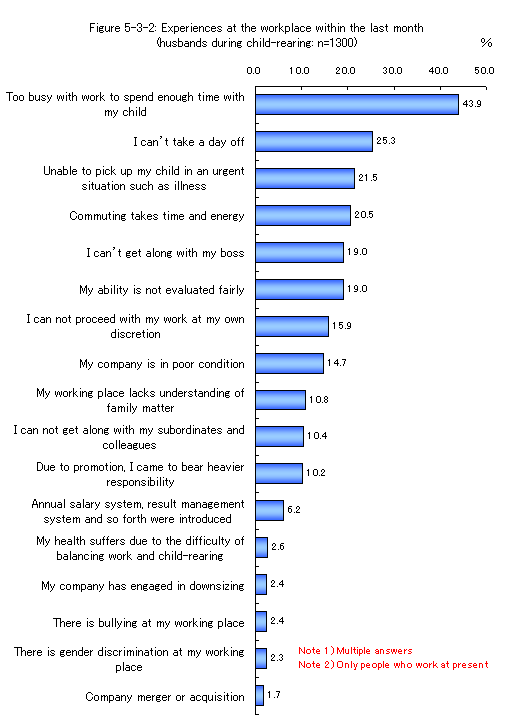
Among two-income families, the percentage living with either the wife's or husband's parents (two-generation house or on the same premises) was higher than that of families of non-working mothers. In addition, children with working mothers saw their grandparents more frequently than children with non-working mothers.
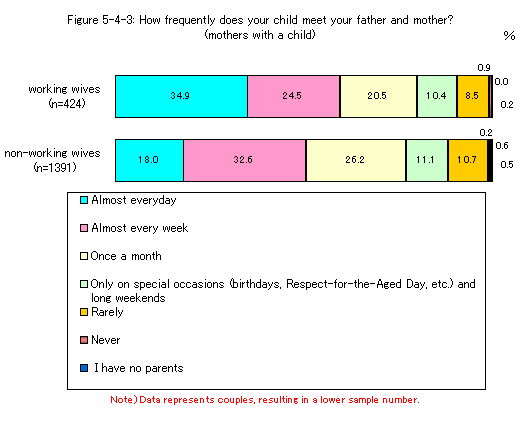
(Noriko Goto)
Chapter 6. QOL during pregnancy/child-caring period
In this chapter, the Quality Of Life (QOL) of wives and husbands in the pregnancy/child-caring period will be analyzed using the WHO QOL26, a method of assessing QOL,based on the conception of "health" defined by the WHO. The QOL index of the wives was consistently higher than that of husbands during the pregnancy/child-caring period (when children are 0, 1, 2 years of age), and the gap between wives and husbands with 2-year-old children was the largest. Furthermore, the QOL during the child-caring period was lower compared to that of pregnancy period both for wives and husbands. In the case of the wives, there was no great change in the QOL during pregnancy and the child-caring period; however, there was a gradually decreasing trend in the QOL of husbands as their children got older.
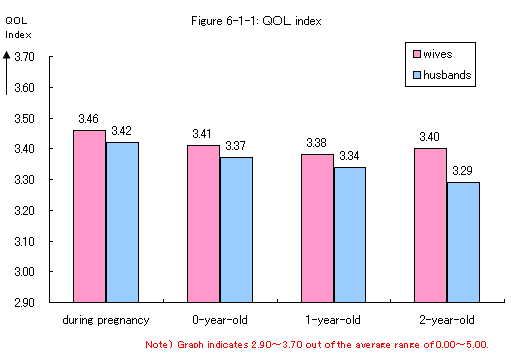
WHO QOL26 consists of four categories: physical, psychological, social relationships and the environment and the responses of wives and husbands were compared in each category. In response to questions in psychological category such as "To what degree do you enjoy your daily life?" and "Are you satisfied with yourself?" during pregnancy and child-rearing by children's age, the wives figures for QOL are lower than that of the husbands. However, in social relationships, including interpersonal aspects, wives show a consistently higher QOL than that of the husbands and indicate that wives have good social relationships.
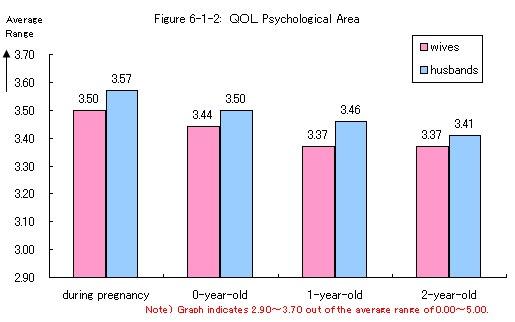
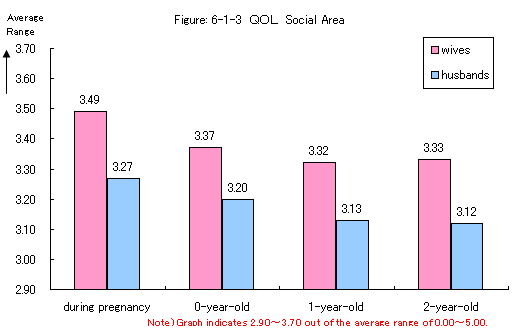
There was no significant difference between wives and husbands in the evaluation of ones' own emotional support for his/her spouse (expressing appreciation for work, household duties, and child-caring, being receptive to the spouse's troubles, etc.). However, wives consistently evaluated emotional support from their spouse lower than the husbands did.
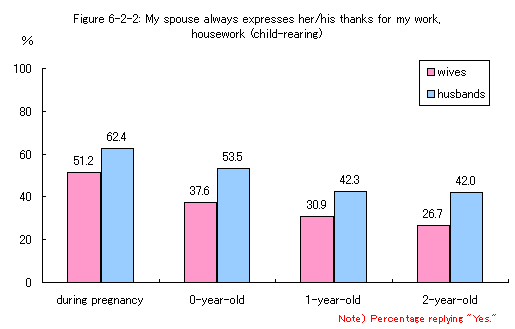
To the question "I thank and reward well my spouse for his/her work, household duties and child-rearing", the QOL of the "Yes" group ("Yes" and "Somewhat") is higher than the QOL of the "No" group ("Not particularly" and "No"). Couples that feel they help each other by sharing household duties and child-rearing show a higher QOL than couples that do not report such feelings.(Figure 6-2-8) High percentages of both wives and husbands belonging to the former group reply "yes" ("Yes" and "Somewhat") to the question "I think I do fairly well as a parent"( Figure 6-2-9)
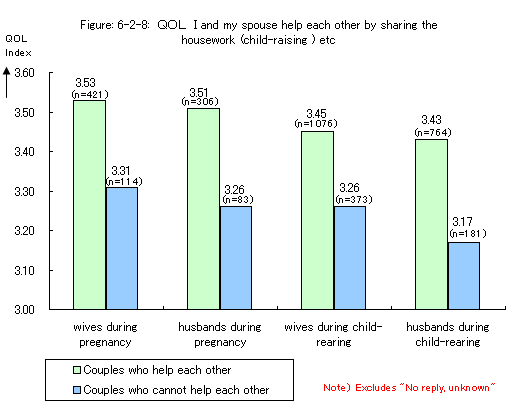
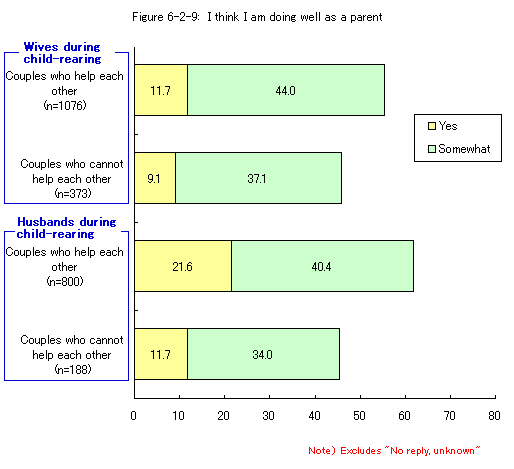
Figure 6-2-7 illustrates the affectionate relationship toward the spouse compared with before pregnancy and childbirth. There is little difference in the percentages of wives and husbands who answer yes ("Yes" and "Somewhat") to the question "I feel more affectionate toward my spouse now than before pregnancy" when they are asked during pregnancy, but the percentage of wives answering "yes" is 13.7 points lower than that of husbands during child-rearing. It can be assumed that couples' affectionate relationships change after the birth of the first child.
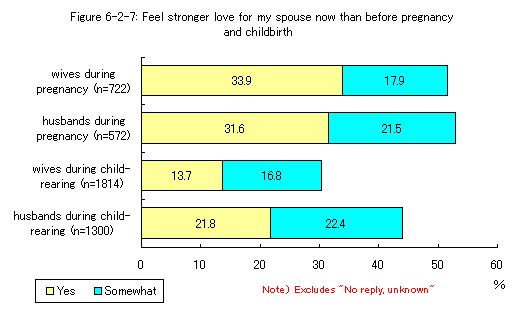
As to the environment supporting child-care during the child-rearing period, the QOL is higher among both wives and husbands who have parks, support centers, and pediatric or obstetric hospitals in the neighborhood (within 20-minute distance on foot). The QOL is lower for those living in houses that are not conveniently designed for raising children or privacy. This indicates the convenience of the household environment for childrearing is a relevant factor (Table 6-3-2). The QOL of parents is also related to whether there are people who care about children and raising children in the neighborhood (Table 6-3-3).
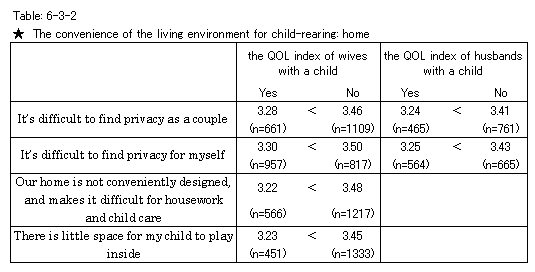
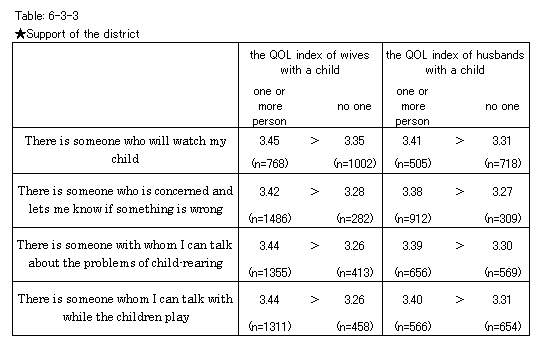
(Masumi Sugawara, Junko Takaoka, Seiko Mochida)
Masumi Sugawara, Professor, Ochanomizu University
Noriko Goto, Senior Researcher, Benesse Institute for the Child Sciences and Parenting
Junko Takaoka, Senior Researcher, Benesse Institute for the Child Sciences and Parenting
Seiko Mochida, Researcher, Benesse Institute for the Child Sciences and Parenting














